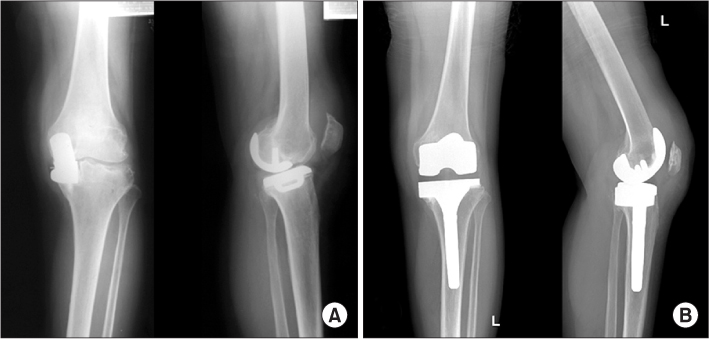J Korean Orthop Assoc.
2012 Oct;47(5):337-343. 10.4055/jkoa.2012.47.5.337.
Total Knee Arthroplasty after Failed Unicompartmental Knee Arthroplasty
- Affiliations
-
- 1Department of Orthopedic Surgery, Seoul Sacred Heart General Hospital, Seoul, Korea. kodongo@naver.com
- KMID: 2185317
- DOI: http://doi.org/10.4055/jkoa.2012.47.5.337
Abstract
- PURPOSE
To identify the causes of failure after unicompartmental knee arthroplasty (UKA), and to evaluate considerations for surgical procedures and the results of revision total knee arthroplasty (TKA) performed after failure of UKA.
MATERIALS AND METHODS
Eight hundreds and fifty-two cases of UKA were performed from January 2002 to June 2011. Forty-seven cases of failures after UKA were analyzed for the cause of the failures, and thirty-five cases of revision TKA after failure were analyzed for the operative findings and surgical technique. The clinical results were measured for thirty cases which were followed-up on at least two years after TKA. The mean duration of follow-up was four years and one month after revision TKA and the mean patient age at the time of surgery was sixty-five years.
RESULTS
For the cause of failures after UKA, there were twenty-two cases of early loosening of prosthesis, seventeen cases of simple mobile bearing dislocation, five cases of infection, one case of fracture of medial tibial condyle and two cases of unknown origin pain. In operative findings of thirty-five cases of TKA after failed UKA, there were twenty-seven cases of bone defect requiring treatment and the mean thickness of the defect was 10.6 mm. For the treatment of bone defect, there were five cases of autogenous bone graft, twenty-one cases of metal blocks, and one case of autogenous bone graft with metal block. The stem was used in tibial implants for nineteen cases, and one case of use in tibial and femoral implants. For thirty cases where follow-ups were possible at least two years after operation, the mean knee score was improved from 68.2 to 85.2 and the mean knee function score was improved from 67.7 to 78.0 at the last follow-up, respectively. The mean range of knee motion was 107.2degrees pre-operatively, which was recovered to 120.7degrees after the operation. The mean tibiofemoral angle was changed from 1.7degrees of valgus to 5.2degrees of valgus.
CONCLUSION
As shown in this study, the tibial bone defect was the most important problem in revision TKA after failure of UKA. Therefore, proper indication and accurate surgical technique using autogenous bone graft, metal block and stemmed implants would be able to achieve satisfactory results in revision TKA after failure of UKA.
Keyword
MeSH Terms
Figure
Reference
-
1. Clark M, Campbell DG, Kiss G, Dobson PJ, Lewis PL. Reintervention after mobile-bearing Oxford unicompartmental knee arthroplasty. Clin Orthop Relat Res. 2010. 468:576–580.
Article2. Padgett DE, Stern SH, Insall JN. Revision total knee arthroplasty for failed unicompartmental replacement. J Bone Joint Surg Am. 1991. 73:186–190.
Article3. Dudley TE, Gioe TJ, Sinner P, Mehle S. Registry outcomes of unicompartmental knee arthroplasty revisions. Clin Orthop Relat Res. 2008. 466:1666–1670.
Article4. Kim KT, Lee S, Park HS, Cho KH, Kim KS. A prospective analysis of Oxford phase 3 unicompartmental knee arthro plasty. Orthopedics. 2007. 30:5 Suppl. 15–18.5. Miller M, Benjamin JB, Marson B, Hollstien S. The effect of implant constraint on results of conversion of unicompartmental knee arthroplasty to total knee arthroplasty. Orthopedics. 2002. 25:1353–1357.
Article6. Lewold S, Robertsson O, Knutson K, Lidgren L. Revision of unicompartmental knee arthroplasty: outcome in 1,135 cases from the Swedish Knee Arthroplasty study. Acta Orthop Scand. 1998. 69:469–474.7. Levine WN, Ozuna RM, Scott RD, Thornhill TS. Conversion of failed modern unicompartmental arthroplasty to total knee arthroplasty. J Arthroplasty. 1996. 11:797–801.
Article8. Järvenpää J, Kettunen J, Miettinen H, Kröger H. The clinical outcome of revision knee replacement after unicompartmental knee arthroplasty versus primary total knee arthroplasty: 8-17 years follow-up study of 49 patients. Int Orthop. 2010. 34:649–653.9. Insall JN, Dorr LD, Scott RD, Scott WN. Rationale of the Knee Society clinical rating system. Clin Orthop Relat Res. 1989. 248:13–14.
Article10. Oduwole KO, Sayana MK, Onayemi F, McCarthy T, O'Byrne J. Analysis of revision procedures for failed unicondylar knee replacement. Ir J Med Sci. 2010. 179:361–364.
Article11. Kim KT, Lee S, Kim JH, Kim TW, Park SY, Lee JS. The effects of patient factors on the functions and clinical results of unicompartmental knee arthroplasty using an oxford mobile bearing prosthesis. J Korean Knee Soc. 2010. 22:241–248.12. Saragaglia D, Estour G, Nemer C, Colle PE. Revision of 33 unicompartmental knee prostheses using total knee arthroplasty: strategy and results. Int Orthop. 2009. 33:969–974.
Article13. Chakrabarty G, Newman JH, Ackroyd CE. Revision of unicompartmental arthroplasty of the knee. Clinical and technical considerations. J Arthroplasty. 1998. 13:191–196.14. Barrett WP, Scott RD. Revision of failed unicondylar unicompartmental knee arthroplasty. J Bone Joint Surg Am. 1987. 69:1328–1335.15. McAuley JP, Engh GA, Ammeen DJ. Revision of failed unicompartmental knee arthroplasty. Clin Orthop Relat Res. 2001. 392:279–282.
Article16. Bae DK, Kwon OS, Shin DJ, Im YJ. Revision total knee arthroplasty of failed unicompartmental knee arthroplasty. J Korean Knee Soc. 2002. 14:16–23.17. Lai CH, Rand JA. Revision of failed unicompartmental total knee arthroplasty. Clin Orthop Relat Res. 1993. 287:193–201.
Article
- Full Text Links
- Actions
-
Cited
- CITED
-
- Close
- Share
- Similar articles
-
- Dislocation of the Polyethylene Bearing of the Medial Unicompartmental Knee Arthroplasty: A Case Report
- Early Major Complications Following Unicompartmental Knee Arthroplasty: Three Case Reports
- Comparative analysis between inset and L-cut method of unicompartmental knee arthroplasty
- Clinical Results of Unicompartmental Knee Arthroplasty
- Snapping Pes Syndrome after Unicompartmental Knee Arthroplasty


